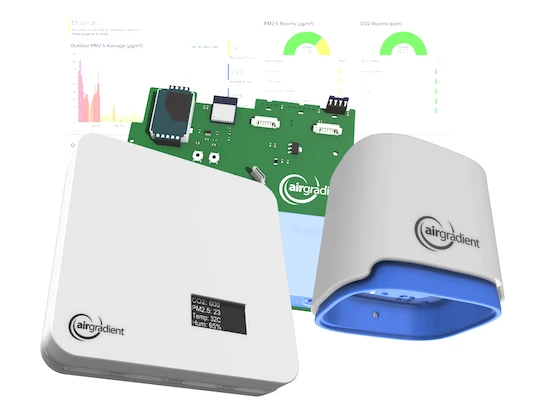AirGradient Open Source Air Quality Monitors
We design professional, accurate and long-lasting air quality monitors that are open-source and open-hardware so that you have full control on how you want to use the monitor.
Learn Moreby Achim Haug on September 22, 2024
In 2013, China experienced an “airpocalypse,” where the air quality drastically deteriorated, making clean air a luxury only the wealthy could afford. During that time, air purifiers on the market were priced at around $1000, a cost prohibitive to many. This raised an important question: Why did these machines cost so much? Did clean air really have to be that expensive?

Through research, Paddy Robertson, CEO of Smart Air, discovered that the answer was a resounding no. This realization sparked the creation of a simple yet effective solution: a DIY home air purifier made from a basic fan and a HEPA filter, costing only £30. With this invention, clean air became affordable and accessible to everyone.
The idea quickly gained traction, and people were eager to learn more about air pollution and affordable solutions. This led to Smart Air creating workshops to share knowledge and inspire action. Thus, Smart Air was born — a social enterprise with a mission to make clean air accessible to all. Initially focused on education, Smart Air soon expanded its offerings to include a range of air purifiers, air quality monitors, and services across the world, now present in over 15 countries.
The journey was not without its challenges. Like any startup, Smart Air faced significant hurdles, particularly in funding and credibility. Multiple investors offered capital, but only if Smart Air sold its purifiers at higher prices with larger profit margins. Staying true to their mission, Smart Air refused these offers, opting for slow growth and careful management of stock and cash flow over compromising their values. Credibility was another major hurdle. Other companies in the air purifier market often discredited Smart Air. To counter this, Smart Air took a bold step: they open-sourced all their test data, letting the numbers speak for themselves.
“One of our core values is data-backed, so everything we say must be backed up by open-data which is very unlike many marketing campaigns nowadays. By pointing people to the data, and not asking them to believe us”, said Paddy Robertson, CEO of Smart Air.
This radical transparency built trust and distinguished Smart Air in a market often dominated by flashy marketing claims with little substance.
Smart Air’s products have made a significant impact on communities and individuals. By raising awareness about affordable clean air solutions, Smart Air helped reduce the cost of clean air in China, creating a wave of awareness and trust in cheaper models. This movement spread globally, and during the COVID-19 pandemic, the DIY air purifier concept saw a resurgence, with Smart Air playing a crucial role.
Beyond products, Smart Air has engaged in numerous community projects. Initiatives such as creating the first Clean Air Club in the US have improved public spaces, making them safer and more inclusive. Donations to care homes, schools, hospitals, and libraries have brought clean air to those who need it most. To date, Smart Air has donated purifiers to many organizations and conducted more than 800 free workshops on clean air, educating thousands on building DIY air purifiers and understanding air pollution better.
The social-enterprise model presents unique challenges, particularly in gaining acceptance and understanding. As Smart Air isn’t a traditional NGO or a purely for-profit business, it often faces difficulties in collaborations. Commercial companies tend to avoid partnerships due to differing profit motivations, while NGOs may hesitate because Smart Air doesn’t fit the typical non-profit mold.
However, the landscape is changing as the social-enterprise model gains recognition for its effectiveness in driving change. Smart Air is actively advocating for the legal recognition of social enterprises, seeking to bridge the gap between profit-driven and mission-focused organizations.
Smart Air’s commitment to sustainability is evident in their product design and practices. By eliminating unnecessary features and ensuring products are recyclable and environmentally friendly, Smart Air sets a high standard. Notably, their packaging is 98% plastic-free and they are actively working to achieve full plastic-free packaging across all their purifier lines.
Recent innovations include replacing aluminum in their Blast and Blast Mini HEPA filters with cardboard, resulting in filters that last upwards of 18 months with a significantly reduced environmental footprint. Smart Air collaborates closely with eco-conscious manufacturers, driving them towards improved practices, further enhancing their positive impact on the environment.
Reflecting on their journey, Smart Air emphasizes the importance of being different and proud of their mission. Building a team united by the same mission and having a clearly defined mission statement from the start are crucial. Despite financial constraints, Smart Air’s cautious approach has led to stability and growth. Their advice to other social impact-driven companies is to trust in their mission and take bold steps, confident that doing right by the planet will ultimately lead to success.
It’s great to see the success and development of Smart Air, especially as we at AirGradient have a similar impact driven mission. There are a lot of similarities how both of our companies started with our DIY air quality monitor kits and their DIY purifiers and it will be very interesting to see how this concept grows and develops further.
Curious about upcoming webinars, company updates, and the latest air quality trends? Sign up for our weekly newsletter and get the inside scoop delivered straight to your inbox.
Join our Newsletter
We design professional, accurate and long-lasting air quality monitors that are open-source and open-hardware so that you have full control on how you want to use the monitor.
Learn More